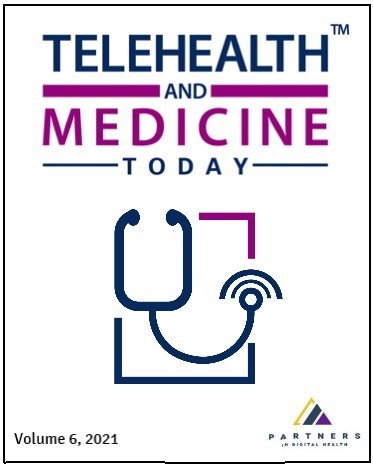Maximizing VA remote patient monitoring during the COVID-19 response
DOI:
https://doi.org/10.30953/tmt.v6.281Keywords:
COVID-19 pandemic, remote patient monitoring, home telehealth, VA, Veteran’s AdministrationAbstract
Objective: The Veterans Health Administration (VHA) has one of the largest remote patient monitoring programs in the United States and is supported by an enterprise-wide infrastructure for providers, clinicians, staff, Veterans, and caregivers. The coronavirus disease 2019 (COVID-19) pandemic, however, presented new challenges: a sudden need to provide large-scale remote monitoring for a new disease that did not yet have a disease management protocol (DMP). Veterans Health Administration (VHA) needed to be ready within weeks to provide this daily monitoring for hundreds – even thousands – of Veterans.
Methods: The US Department of Veterans Affairs Office of Connected Care already had a comprehensive infrastructure in place for its remote patient monitoring – Home Telehealth (RPM – HT) program. Connected Care activated and built on this infrastructure to support providers, clinicians, and staff in their efforts to rapidly bring RPM – HT to Veterans across the nation when they had COVID-19 symptoms or exposure. To do this, Connected Care activated an emergency management plan, rapidly developed a new COVID-19-specific DMP, added weekend monitoring, and procured critically needed monitoring supplies, such as thermometers and pulse oximeters. The strong foundation for Connected Care allowed for innovation and flexibility, such as the training of non-RPM – HT staff in RPM – HT processes, RPM – HT enrollment within acute care settings, and new strategic partnerships.
Outcomes: More than 23,500 Veterans were enrolled for COVID-19-related monitoring from March 2020 to May 2021. During December 2020 and January 2021, the number of Veterans being monitored in a single day topped 2,000. Even with this rapid buildup, patient satisfaction levels remained at about 90% in numerous categories. In addition, the percentage of Veterans admitted to Veterans Administration (VA) facilities while on COVID-19-related home monitoring has been extremely low, at 4%, the monitoring system has been a potential indicator in enabling Veterans who did have the virus to convalesce at home. Further study is needed to determine the impact RPM – HT enrollment for COVID-19 care had on the need for inpatient care.
Conclusion: The Office of Connected Care’s established, enterprise-wide RPM – HT business, clinical, and technical infrastructure enabled VHA to enter the COVID-19 public health emergency well-positioned for the rapid deployment and growth of at-home and mobile monitoring. As the COVID-19 emergency made at-home management of Veterans increasingly important, the national RPM – HT program successfully adapted its practices to meet the needs of Veterans, caregivers, and staff.
Downloads
References
1. Peters J. VHA Talking points – Telehealth, Fiscal 2019. Washington, DC: U.S. Department of Veterans Affairs, Veterans Health Administration; 2019.
2. Department of Veterans Affairs COVID-19 National Summary. [Internet]. Washington, DC: U.S. Department of Veterans Affairs; 2021. Available from: https://www.accesstocare.va.gov/Healthcare/COVID19NationalSummary [cited 21 May 2021].
3. Rollins A. COVID dashboard RPM-HT vendors COVID enrollment census data. Washington, DC: U.S. Department of Veterans Affairs, Office of Healthcare Transformation Division; 2021.
4. Johnston R, Kobb RF, Marty C, McVeigh P. VA video telehealth and training programs during the COVID-19 response. TMT 2021 Jan 24;6(1). doi: 10.30953/tmt.v6.241
5. Cruickshank J. Telehealth: what can the NHS learn from experience at the U.S. Veterans Health Administration. [Internet]. London: 2020health.org; 2012 Jan 6. Available from: https://www.bl.uk/collection-items/telehealth-what-can-the-nhs-learn-from-experience-at-the-us-veterans-health-administration# [cited 22 July 2021].
6. Kobb R, Chumbler NR, Rabinowitz T, Brennan D. Home telehealth: mainstreaming what we do well. Telemed J E Health 2008; 14(9): 977–81. doi: 10.1089/tmj.2008.0121
7. Darkins A, Ryan P, Kobb R, Foster L, Edmonson E, Wakefield B, et al. Care coordination/home telehealth: the systematic implementation of health informatics, home telehealth and disease management to support the care of veteran patients with chronic conditions. Telemed J E Health 2008; 14(9): 1118–26. doi: 10.1089/tmj.2008.0021
8. Meyer M, Ryan P, Kobb R, Roswell R. Identifying veterans’ needs for home telehealth. Fed Pract 2003; 20(8): 24–41.
9. Meyer M, Kobb R, Ryan P, Gokalp H. Virtually healthy: chronic disease management in the home. Dis Manag 2004 Jul 5; 5(2): 87–94. doi: 10.1089/109350702320229186
10. Use of remote patient monitoring – Home Telehealth technologies for COVID-19. [Internet]. Washington, DC: U.S. Department of Veterans Affairs; 2020 Mar 25. Available from: https://dvagov.sharepoint.com/:w:/r/sites/VACOVHAPublicHealth/HCI/_layouts/15/Doc.aspx?sourcedoc=%7B44773601-EBC2-4826-975B-D106BB4DD3E2%7D&file=Primary%20Care%20Field%20Guide%20for%20Managing%20COVID-19_FINAL%20to%2010N.docx&action=default&mobileredirect=true.
Published
How to Cite
Issue
Section
License
Copyright (c) 2021 Catherine Buck, Rita Kobb, Ron Sandreth, Lisa Alexander, Sherron Olliff, Carla Anderson, Carol Westfall, Laurie Graaff, Joseph Giovannucci, Aszur Rollins

This work is licensed under a Creative Commons Attribution-NonCommercial 4.0 International License.
Authors retain copyright of their work, with first publication rights granted to Telehealth and Medicine Today (THMT).
THMT is published under a Creative Commons Attribution-NonCommercial 4.0 International License.

















